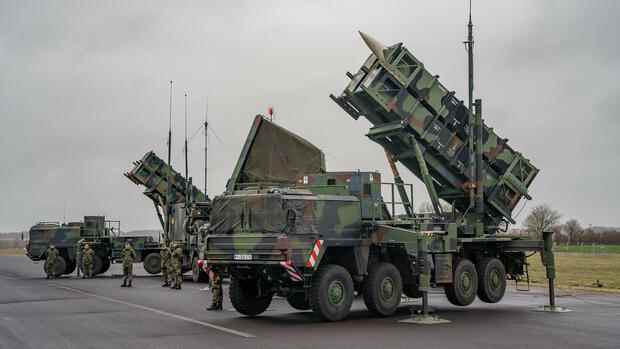So far, the Bundeswehr has relied on US weapons, but Israeli models could probably be added in the future.
(Photo: dpa)
Berlin Together with other nations, Germany wants to set up a European protective shield against rocket attacks. A total of 15 countries have come together, said Federal Defense Minister Christine Lambrecht (SPD) on Thursday after signing a corresponding “Letter of Intent” in Brussels.
European air defense is an area “where we have gaps,” said the minister. It is important to close these gaps because we live in “threatening and challenging times”. Lambrecht is alluding to Ukraine, where the Russian army had fired at targets with long-range missiles in the past few days. Germany has already delivered a state-of-the-art Iris-T SL missile defense system to Ukraine and intends to provide three more.
The aim of the planned “European Sky Shield” is to protect Europe from attacks by planes, drones or rockets. For this purpose, defense systems of different ranges are to be combined in order to be able to react to low-flying missiles as well as to ballistic missiles that rise into orbit.
The minister announced that they would therefore jointly expand the existing air defense system with Patriot missiles, but also purchase new systems such as the ground-based Iris-T SL. The Arrow 3 system, jointly developed by Israel and the USA, is under discussion for defense against ballistic missiles.
Top jobs of the day
Find the best jobs now and
be notified by email.
Members of the Defense Committee traveled to Israel in March this year to have the system demonstrated. It competes with the more expensive US system THAAD, which can intercept ballistic missiles at even higher altitudes. A decision has not yet been made, but she thinks Arrow 3 “would be the right system,” said Lambrecht. The Ministry of Defense points out that Arrow 3 is available more quickly and can be used more mobile than the US version.
Countries join forces to negotiate lower prices
The cooperation with the European allies should have several advantages. On the one hand, it is about being “interoperable”. It should be avoided that each country buys different systems that cannot or only with difficulty be used together. The protective effect is greater, especially with far-reaching systems, when several states join forces.
By placing a joint order, the 15 participating countries could also use their market power and enforce lower prices from manufacturers. In addition, the states could support each other in maintenance.
The Federal Defense Minister signed the so-called European Sky Shield Initiative at a NATO meeting in Brussels.
(Photo: IMAGO/UPI Photo)
Lambrecht did not want to comment on the costs that Germany would incur. You have the opportunity to access the 100 billion euro special fund. The figure of 20 billion euros is circulating within the government. Ultimately, however, the costs depended on how many states participated in the end.
The “European Sky Shield” is also open to other partners. “We are open to anyone who would like to get involved within NATO,” said the Federal Defense Minister. The aim is to subordinate the protective shield to the supreme commander of NATO in Europe (Saceur).
Chancellor Olaf Scholz (SPD) had already pointed out deficits in air defense in his European policy speech in Prague at the end of August and suggested a common European system.
Acquisition may take years
The NATO partners admit that they have deficits in air defense – in all “intercept positions”, as they call it, high, medium and low ground. Air defense was neglected because it was of no importance in the fight against terrorist groups. For a long time, the alliance concentrated on its mission in Afghanistan. There, NATO troops helped fight the Taliban. The Islamic insurgents were generally lightly armed and had no air units.
Only now, in the confrontation with Russia, is the capability gap clearly becoming apparent. The Russian armed forces have different missile systems, they can launch cruise missiles and launch drones.
The threat posed by drones in particular is likely to continue to increase, and NATO is talking about “drone inflation”. A large squadron of unmanned aerial vehicles can quickly overwhelm current air defense systems.
Western military officials concede it will take years to make up for the shortfalls. Arrow 3 can therefore be available in 2025 at the earliest.
More: What can the Iris-T SLM anti-aircraft system do?
